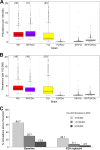A Multistrain Mathematical Model To Investigate the Role of Pyrazinamide in the Emergence of Extensively Drug-Resistant Tuberculosis
- PMID: 27956422
- PMCID: PMC5328532
- DOI: 10.1128/AAC.00498-16
A Multistrain Mathematical Model To Investigate the Role of Pyrazinamide in the Emergence of Extensively Drug-Resistant Tuberculosis
Abstract
Several infectious diseases of global importance-e.g., HIV infection and tuberculosis (TB)-require prolonged treatment with combination antimicrobial regimens typically involving high-potency core agents coupled with additional companion drugs that protect against the de novo emergence of mutations conferring resistance to the core agents. Often, the most effective (or least toxic) companion agents are reused in sequential (first-line, second-line, etc.) regimens. We used a multistrain model of Mycobacterium tuberculosis transmission in Southeast Asia to investigate how this practice might facilitate the emergence of extensive drug resistance, i.e., resistance to multiple core agents. We calibrated this model to regional TB and drug resistance data using an approximate Bayesian computational approach. We report the proportion of data-consistent simulations in which the prevalence of pre-extensively drug-resistant (pre-XDR) TB-defined as resistance to both first-line and second-line core agents (rifampin and fluoroquinolones)-exceeds predefined acceptability thresholds (1 to 2 cases per 100,000 population by 2035). The use of pyrazinamide (the most effective companion agent) in both first-line and second-line regimens increased the proportion of simulations in which the prevalence exceeded the pre-XDR acceptability threshold by 7-fold compared to a scenario in which patients with pyrazinamide-resistant TB received an alternative drug. Model parameters related to the emergence and transmission of pyrazinamide-resistant TB and resistance amplification were among those that were the most strongly correlated with the projected pre-XDR prevalence, indicating that pyrazinamide resistance acquired during first-line treatment subsequently promotes amplification to pre-XDR TB under pyrazinamide-containing second-line treatment. These findings suggest that the appropriate use of companion drugs may be critical to preventing the emergence of strains resistant to multiple core agents.
Keywords: antimicrobial combinations; mathematical modeling; multidrug resistance; pyrazinamide; tuberculosis.
Copyright © 2017 Fofana et al.
Figures





Comment in
-
Protecting Pyrazinamide, a Priority for Improving Outcomes in Multidrug-Resistant Tuberculosis Treatment.Antimicrob Agents Chemother. 2017 May 24;61(6):e00258-17. doi: 10.1128/AAC.00258-17. Print 2017 Jun. Antimicrob Agents Chemother. 2017. PMID: 28539498 Free PMC article. No abstract available.
-
Reply to Anthony et al., "Protecting Pyrazinamide, a Priority for Improving Outcomes in Multidrug-Resistant Tuberculosis Treatment".Antimicrob Agents Chemother. 2017 May 24;61(6):e00427-17. doi: 10.1128/AAC.00427-17. Print 2017 Jun. Antimicrob Agents Chemother. 2017. PMID: 28539499 Free PMC article. No abstract available.
Similar articles
-
Beyond multidrug-resistant tuberculosis in Europe: a TBNET study.Int J Tuberc Lung Dis. 2015 Dec;19(12):1524-7. doi: 10.5588/ijtld.15.0274. Int J Tuberc Lung Dis. 2015. PMID: 26614196
-
Whole-genome sequencing of clinical isolates from tuberculosis patients in India: real-world data indicates a high proportion of pre-XDR cases.Microbiol Spectr. 2024 May 2;12(5):e0277023. doi: 10.1128/spectrum.02770-23. Epub 2024 Apr 10. Microbiol Spectr. 2024. PMID: 38597637 Free PMC article.
-
Pyrazinamide resistance in Mycobacterium tuberculosis arises after rifampicin and fluoroquinolone resistance.Int J Tuberc Lung Dis. 2015 Jun;19(6):679-84. doi: 10.5588/ijtld.14.0768. Int J Tuberc Lung Dis. 2015. PMID: 25946359
-
Extensively drug-resistant tuberculosis: new strains, new challenges.Expert Rev Anti Infect Ther. 2008 Oct;6(5):713-24. doi: 10.1586/14787210.6.5.713. Expert Rev Anti Infect Ther. 2008. PMID: 18847407 Review.
-
Antibiotic resistance acquisition versus primary transmission in the presentation of extensively drug-resistant tuberculosis.Int J Mycobacteriol. 2022 Oct-Dec;11(4):343-348. doi: 10.4103/ijmy.ijmy_187_22. Int J Mycobacteriol. 2022. PMID: 36510916 Review.
Cited by
-
Whole-Genome Sequencing To Guide the Selection of Treatment for Drug-Resistant Tuberculosis.Antimicrob Agents Chemother. 2018 Jul 27;62(8):e00574-18. doi: 10.1128/AAC.00574-18. Print 2018 Aug. Antimicrob Agents Chemother. 2018. PMID: 30054376 Free PMC article. No abstract available.
-
Mathematical models of drug-resistant tuberculosis lack bacterial heterogeneity: A systematic review.PLoS Pathog. 2024 Apr 10;20(4):e1011574. doi: 10.1371/journal.ppat.1011574. eCollection 2024 Apr. PLoS Pathog. 2024. PMID: 38598556 Free PMC article.
-
Reply to Anthony et al., "Protecting Pyrazinamide, a Priority for Improving Outcomes in Multidrug-Resistant Tuberculosis Treatment".Antimicrob Agents Chemother. 2017 May 24;61(6):e00427-17. doi: 10.1128/AAC.00427-17. Print 2017 Jun. Antimicrob Agents Chemother. 2017. PMID: 28539499 Free PMC article. No abstract available.
-
Pyrazinamide Is a Two-Edged Sword: Do WHO Guidelines Matter?Antimicrob Agents Chemother. 2017 Dec 21;62(1):e01907-17. doi: 10.1128/AAC.01907-17. Print 2018 Jan. Antimicrob Agents Chemother. 2017. PMID: 29269428 Free PMC article. No abstract available.
-
Dynamic model of tuberculosis considering multi-drug resistance and their applications.Infect Dis Model. 2018 Nov 17;3:362-372. doi: 10.1016/j.idm.2018.11.001. eCollection 2018. Infect Dis Model. 2018. PMID: 30839915 Free PMC article.
References
-
- World Health Organization. 2014. Antimicrobial resistance: global report on surveillance 2014. World Health Organization, Geneva, Switzerland: http://www.who.int/drugresistance/documents/surveillancereport/en/ Accessed 29 June 2015.
MeSH terms
Substances
Grants and funding
LinkOut - more resources
Full Text Sources
Other Literature Sources

